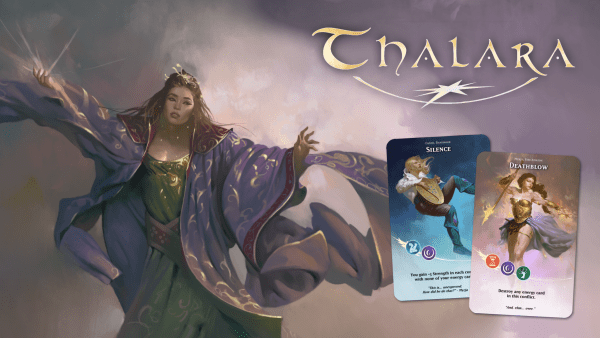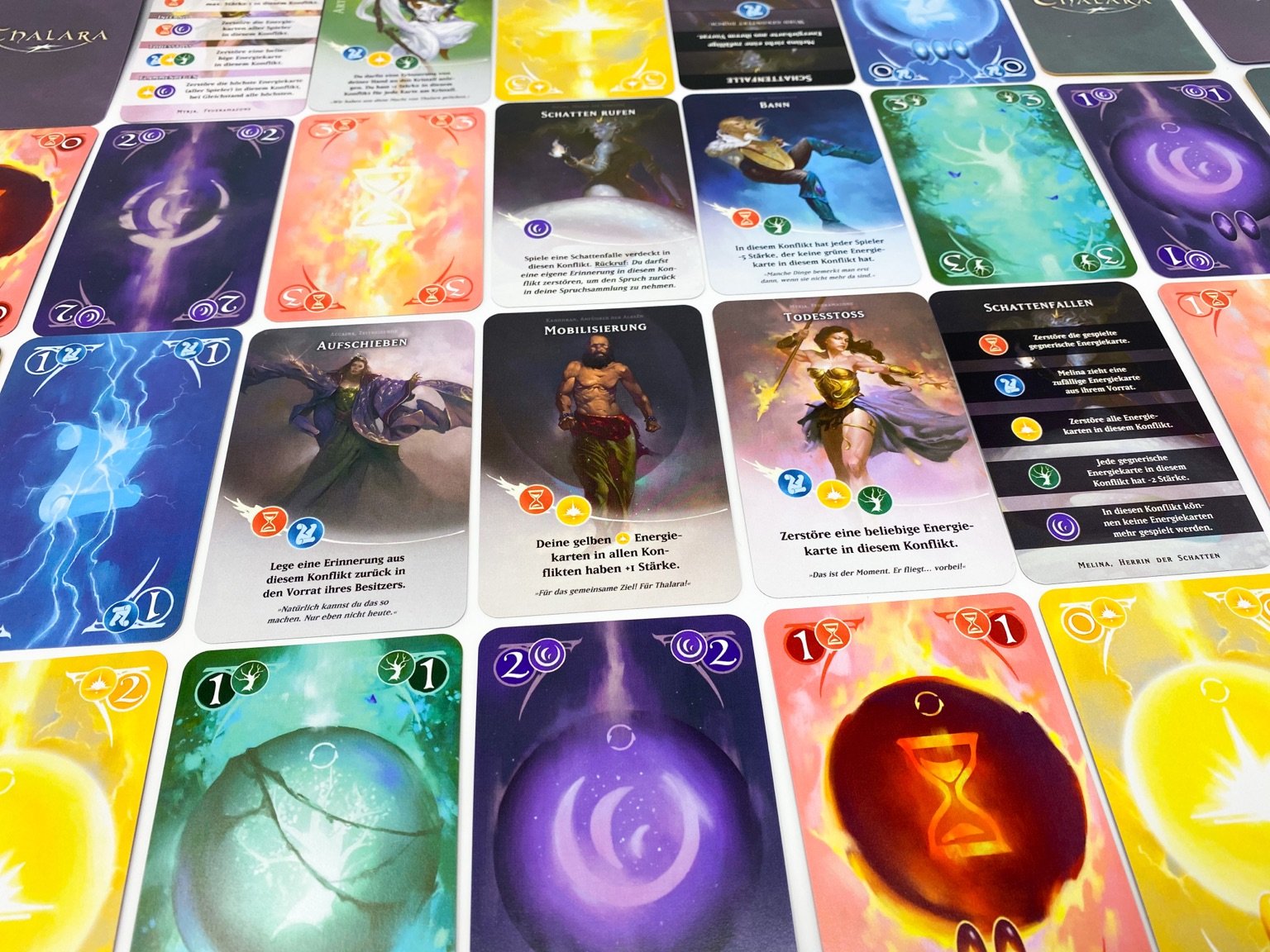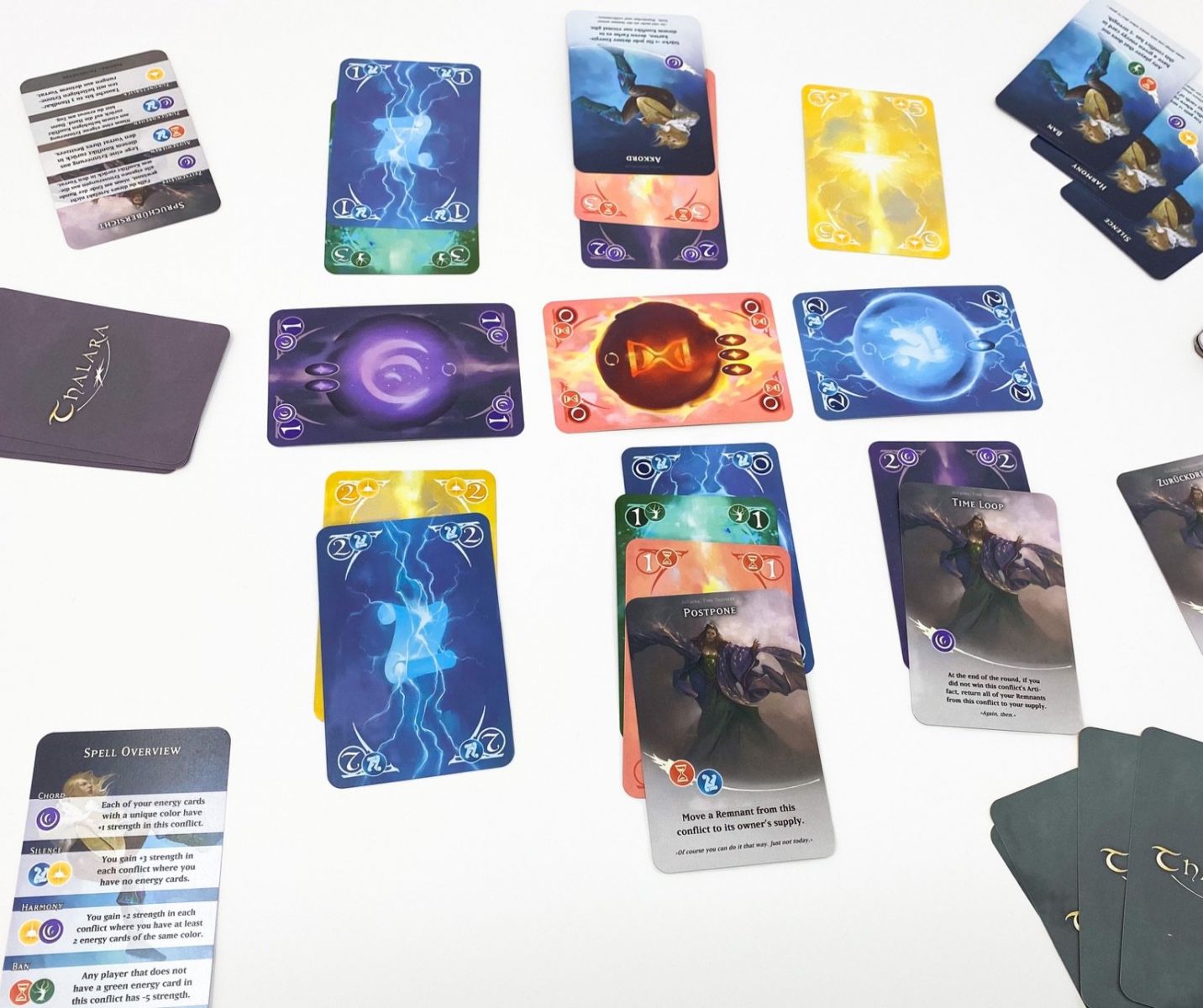Preview: Take Part in a Magical Duel with Dwindling Resources in Thalara: The Last Artifacts

The world is dying and magic is fading. Only by harnessing powerful artifacts will you be able to retain your powers. However, the artifacts are in short supply and you must compete against fellow magic users to claim the coveted artifacts.
Currently on Kickstarter, Thalara: The Last Artifacts is a strategic card game with hand management and dueling elements.

Photo provided by the publisher
Gameplay
Each player chooses a character and places the character’s four spells in front of themselves. They then give their character’s spell overview card to their opponent, so that both players always know what spells the other has at their disposal. Additionally, each player takes a set of twenty remnant cards. Remnants come in five different colors and have strength values ranging from one through five.
At the start of a two-player game, you draw three artifact cards and place them face-up on the table. Artifacts also come in the five different colors of remnants, have a strength value, and a point value. At the start of the first round, players go through their remnant decks and secretly select seven cards to form their hand.
The start player then plays a remnant card face up to any of the three artifacts. The cards played to an artifact are called a conflict. Players then take turns playing cards to any of the three artifacts. You may keep adding cards until your hand is empty or until you choose to pass. Once you have passed, the other player may continue to play cards. Any remnant cards you do not play during the round are put back in your deck. Once everyone has finished playing cards, you check whose cards in each conflict have the highest combined value and they win the artifact, adding it to their hand.
Any remnant cards that were played to an artifact are placed into a discard pile. Consequently, you will have fewer remnant cards to choose from next round when making up your hand. Also, you can never have more than seven cards in your hand, and each artifact card you win takes up a spot in your hand, meaning you will be able to take fewer remnants next round when you win an artifact. Artifacts can be played like remnant cards on subsequent rounds to help you win more artifacts, and rather than being discarded at the end of the round they are returned to your hand.
To set up the next round, you draw new artifact cards to replace those that were claimed, each player chooses remnant cards from their deck until they have a hand of seven again, and the player who played a card last in the previous round becomes start player.
Whenever you play a card, you may also choose to cast a spell. Each spell requires you to have played certain colored remnant or artifact cards in a single conflict in order to allow you to play the spell to that same conflict. Spells have abilities such as changing the strength values of certain cards or removing certain cards from a conflict altogether. Spells are returned to their respective players at the end of the round and may be cast again in future rounds.
The game ends once a player has seven or more artifacts or if someone does not have enough cards left in their deck to form a hand of seven. Players then count up the point values of their artifact cards and the player with the most points wins.
A three-to-four player game plays in mostly the same way, although it requires two sets of the game and more artifacts are on the table each round. Also, if there is a tie between two players for winning an artifact then it instead goes to whichever player as in third place in the conflict (or to no one if no one else played cards to the conflict).

Photo provided by the publisher
Review
The gameplay in Thalara: The Last Artifacts is simple to learn but there’s quite a lot going on in the strategy and the decisions you are faced with. The fact that you actually select your hand each turn really minimizes the luck involved, but also raises some difficult choices. When do you want to bring your higher value cards, knowing that once they're used they need to be discarded? You also need to keep in mind which color cards your spells need, and some spells in turn play off specific colors.
Additionally, the way your hand slowly locks into place as you acquire more artifact cards is a clever mechanic that ensures you don’t simply want to grab as many artifacts as you can. You need to consider their strength value, what point you’re at in the game, their color, and how that will play off your spells. An artifact worth three points might be good for the end game, but if its strength value is zero do you really want it cluttering up your hand from round one?
The range of characters with their different spell abilities are impressive and bring variety to the gameplay. Some of the characters even come with additional rules. There is also a suggested variant that allows you to mix and match spells, to essentially create your own customized character.
Playing with two players, the game is more strategic and tactical, while three to four players can more unpredictable, with more spells activating and more contingencies to account for. Remember, you will need two separate packs of the game to play with three to four players, though each pack will come with different characters, so you won’t just be buying the same game twice.
The game’s artwork is gorgeous, particularly the character designs, and it pairs well with the slightly dark fantasy theme behind the game’s story. Even in prototype form, we found the cards to be nice quality, and the spell guides for each character an excellent addition. As an extremely minor point, the colors of the card backs on the different remnant decks were similar enough that we found sorting them to be difficult, but as these do not typically get mixed together during gameplay this was not much of a problem. Update: The publisher has promised to improve the colors on the backs and also add a distinct pattern per color to aid colorblind players.
Thalara: The Last Artifacts is an intriguing card game that leaves you with lots of different options and strategies while keeping the basic gameplay intuitive. It’s well designed and nicely balanced. If you enjoy strategic card games, check it out on Kickstarter.
Pros: Range of characters, simple gameplay with strategic depth, selecting your own hand each round pairs well with artifacts taking up space in your hand
Cons: Need two packs to support 3-4 players, colors on the remnant card backs were hard to distinguish in the prototype
Disclosure: this preview is based on our evaluation of an unpublished prototype of the game, which is subject to change prior to publication. While a modest payment was received to expedite the review process, our thoughts and opinions expressed here are honest and accurate.




